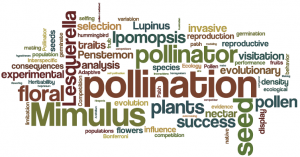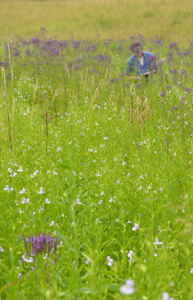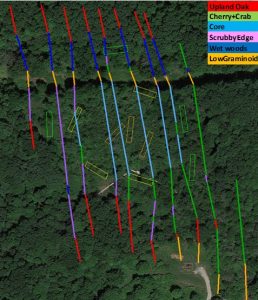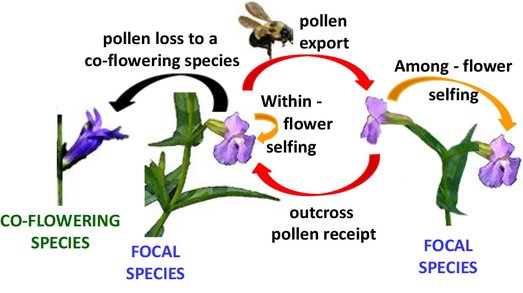My main research interest is in the evolutionary ecology of plant pollinator interactions, focusing on how plant mating patterns and success are affected by pollinator behavior and abundance. This work utilizes a broad array of field, genetic, statistical, histological, horticultural, geographical, imaging, and modeling approaches, drawing from many disciplines in and out of biology. Some of my projects have direct or indirect implications for conservation efforts and management of endangered or invasive species.
interactions, focusing on how plant mating patterns and success are affected by pollinator behavior and abundance. This work utilizes a broad array of field, genetic, statistical, histological, horticultural, geographical, imaging, and modeling approaches, drawing from many disciplines in and out of biology. Some of my projects have direct or indirect implications for conservation efforts and management of endangered or invasive species.
My secondary research area is wetland ecology and restoration. The University of Akron Field Station, and especially Panzner Wetland Wildlife Reserve, provide excellent field opportunities for research on the biology and ecology of wetland plants and animals. My work on this topic focuses on monitoring and restoring wetland habitats, and better understanding their ecology and functions.
Graduate students in my lab work on a wide range of topics, sometimes overlapping with my main interests and sometimes quite independent. More on my students can be found on the ‘people’ page (see menu above)
Examples of some of my current research projects are presented below.
Effects of co-flowering species on the pattern of selection on the mating system.
A major conceptual challenge for evolutionary theory is the frequent occurrence of intermediate rates of self-fertilization in flowering plant populations. This pattern in nature is not consistent with classical genetic models, which predict that disruptive selection will cause intermediate selfing rates to be rare and transitory. Populations with low inbreeding depression should evolve predominant selfing because more maternal alleles are transmitted through self-fertilized seeds than through outcross seeds. By contrast, populations with high inbreeding depression should evolve predominant outcrossing because the transmission advantage of selfing is offset by inbreeding depression. Since populations with intermediate selfing rates are common, researchers have sought to develop and test models that explore conditions favoring stable mixed mating. Several models have highlighted the key role of tradeoffs between siring success and selfing. However, most models ignore a fundamental aspect of plant-pollinator interactions, which is that pollinator movements between species often waste pollen by depositing it on flowers of other species. Such pollen losses reduce outcross siring, increase selfing, and lower seed production, changing tradeoffs and altering selection. Community context can therefore be an important driver of mating system evolution, yet it remains largely unstudied.
In collaboration with Jeff Karron (Univ of Wisconsin Milwaukee), Dorset Trapnell (Univ of Georgia), Emmanuelle Porcher (Muséum National d’Histoire Naturelle) and Celine Devaux (Université de Montpellier), this project combines empirical and theoretical investigations to test the hypothesis that interactions with co-flowering species alter the evolutionary tradeoff between outcross siring and selfing. We are manipulating ecological context to determine whether a change in co-flowering species abundance alters tradeoffs, and shifts the pattern of natural selection on selfing rate. To explore evolutionary response to ecological context and potential synergistic effects of floral display, we are also quantifying selfing rates, pollen limitation, and inbreeding depression in natural populations differing in ecological context and floral display.
Restoration of a tamarack bog?

Transects through the restoration area in 2016, coded by habitat type (using delineated habitat segments identified with cluster analysis and NMDS).
The Bath Nature Preserve includes a remnant Tamarack Bog. Originally 13.8 acres in size, drainage ditches were placed in the 1960s, and the lowered water level reduced the bog habitat to only 4.36 acres. The drier conditions allowed invasion by Red Maples, European Buckthorn, and other troublesome species. A restoration plan was developed and implemented in 2013, and I lead the Monitoring team along with Jean Marie Hartman (Rutgers University Landscape Architecture), and Ira Sasowsky (UA Geology). We are documenting the vegetative and hydrological changes in the area, and providing guidance for restoration efforts. A critical aspect of the restoration is restoration of hydrology, which Bath Township achieved by placing a drainage control structure (Agridrain) at the outlet of the area. Invasive control and removal is also ongoing. Student research has provided important baseline information and exploration of opportunities for seedbank recruitment, expanded growth of Sphagnum moss, and increased tamarack populations.

